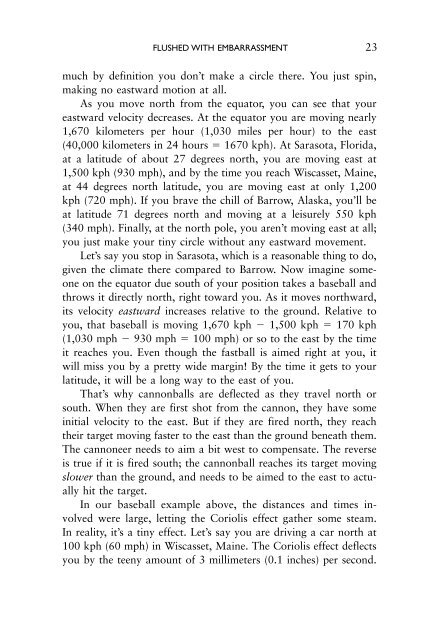Bad Astronomy: Misconceptions and Misuses Revealed, from ...
Bad Astronomy: Misconceptions and Misuses Revealed, from ...
Bad Astronomy: Misconceptions and Misuses Revealed, from ...
Create successful ePaper yourself
Turn your PDF publications into a flip-book with our unique Google optimized e-Paper software.
FLUSHED WITH EMBARRASSMENT 23<br />
much by definition you don’t make a circle there. You just spin,<br />
making no eastward motion at all.<br />
As you move north <strong>from</strong> the equator, you can see that your<br />
eastward velocity decreases. At the equator you are moving nearly<br />
1,670 kilometers per hour (1,030 miles per hour) to the east<br />
(40,000 kilometers in 24 hours � 1670 kph). At Sarasota, Florida,<br />
at a latitude of about 27 degrees north, you are moving east at<br />
1,500 kph (930 mph), <strong>and</strong> by the time you reach Wiscasset, Maine,<br />
at 44 degrees north latitude, you are moving east at only 1,200<br />
kph (720 mph). If you brave the chill of Barrow, Alaska, you’ll be<br />
at latitude 71 degrees north <strong>and</strong> moving at a leisurely 550 kph<br />
(340 mph). Finally, at the north pole, you aren’t moving east at all;<br />
you just make your tiny circle without any eastward movement.<br />
Let’s say you stop in Sarasota, which is a reasonable thing to do,<br />
given the climate there compared to Barrow. Now imagine someone<br />
on the equator due south of your position takes a baseball <strong>and</strong><br />
throws it directly north, right toward you. As it moves northward,<br />
its velocity eastward increases relative to the ground. Relative to<br />
you, that baseball is moving 1,670 kph � 1,500 kph � 170 kph<br />
(1,030 mph � 930 mph � 100 mph) or so to the east by the time<br />
it reaches you. Even though the fastball is aimed right at you, it<br />
will miss you by a pretty wide margin! By the time it gets to your<br />
latitude, it will be a long way to the east of you.<br />
That’s why cannonballs are deflected as they travel north or<br />
south. When they are first shot <strong>from</strong> the cannon, they have some<br />
initial velocity to the east. But if they are fired north, they reach<br />
their target moving faster to the east than the ground beneath them.<br />
The cannoneer needs to aim a bit west to compensate. The reverse<br />
is true if it is fired south; the cannonball reaches its target moving<br />
slower than the ground, <strong>and</strong> needs to be aimed to the east to actually<br />
hit the target.<br />
In our baseball example above, the distances <strong>and</strong> times involved<br />
were large, letting the Coriolis effect gather some steam.<br />
In reality, it’s a tiny effect. Let’s say you are driving a car north at<br />
100 kph (60 mph) in Wiscasset, Maine. The Coriolis effect deflects<br />
you by the teeny amount of 3 millimeters (0.1 inches) per second.
















